The Intel Haswell-E CPU Review: Core i7-5960X, i7-5930K and i7-5820K Tested
by Ian Cutress on August 29, 2014 12:00 PM ESTEvolution in Performance
The underlying architecture in Haswell-E is not anything new. Haswell desktop processors were first released in July 2013 to replace Ivy Bridge, and at the time we stated an expected 3-17% increase, especially in floating point heavy benchmarks. Users moving from Sandy Bridge should expect a ~20% increase all around, with Nehalem users in the 40% range. Due to the extreme systems only needing more cores, we could assume that the suggested recommendations for Haswell-E over IVB-E and the others were similar but we tested afresh for this review in order to test those assumptions.
For our test, we took our previous CPU review samples from as far back as Nehalem. This means the i7-990X, i7-3960X, i7-4960X and the Haswell-E i7-5960X.
Each of the processors were set to 3.2 GHz on all the cores, and set to four cores without HyperThreading enabled.
Memory was set to the CPU supported frequency at JEDEC settings, meaning that if there should Intel have significantly adjusted the performance between the memory controllers of these platforms, this would show as well. For detailed explanations of these tests, refer to our main results section in this review.
Average results show an average 17% jump from Nehalem to SNB-E, 7% for SNB-E to IVB-E, and a final 6% from IVB-E to Haswell-E. This makes for a 31% (rounded) overall stretch in three generations.
Web benchmarks have to struggle with the domain and HTML 5 offers some way to help use as many cores in the system as possible. The biggest jump was in SunSpider, although overall there is a 34% jump from Nehalem to Haswell-E here. This is split by 14% Nehalem to SNB-E, 6% SNB-E to IVB-E and 12% from IVB-E to Haswell-E.
Purchasing managers often look to the PCMark and SYSmark data to clarify decisions and the important number here is that Haswell-E took a 7% average jump in scores over Ivy Bridge-E. This translates to a 24% jump since Nehalem.
Some of the more common synthetic benchmarks in multithreaded mode showed an average 8% jump from Ivy Bridge-E, with a 29% jump overall. Nehalem to Sandy Bridge-E was a bigger single jump, giving 14% average.
In the single threaded tests, a smaller overall 23% improvement was seen from the i7-990X, with 6% in this final generation.
The take home message, if there was one, from these results is that:
Haswell-E has an 8% improvement in performance over Ivy Bridge-E clock for clock for pure CPU based workloads.
This also means an overall 13% jump from Sandy Bridge-E to Haswell-E.
From Nehalem, we have a total 28% raise in clock-for-clock performance.
Looking at gaming workloads, the difference shrinks. Unfortunately our Nehalem system decided to stop working while taking this data, but we can still see some generational improvements. First up, a GTX 770 at 1080p Max settings:
The only title that gets much improvement is F1 2013 which uses the EGO engine and is most amenable to better hardware under the hood. The rise in minimum frame rates is quite impressive.
For SLI performance:
All of our titles except Tomb Raider get at least a small improvement in our clock-for-clock testing with this time Bioshock also getting in on the action in both average and minimum frame rates.
If we were to go on clock-for-clock testing alone, these numbers do not particularly show a benefit from upgrading from a Sandy Bridge system, except in F1 2013. However our numbers later in the review for stock and overclocked speeds might change that.
Memory Latency and CPU Architecture
Haswell is a tock, meaning the second crack at 22nm. Anand went for a deep dive into the details previously, but in brief Haswell bought better branch prediction, two new execution ports and increased buffers to feed an increased parallel set of execution resources. Haswell adds support for AVX2 which includes an FMA operation to increase floating point performance. As a result, Intel doubled the L1 cache bandwidth. While TSX was part of the instruction set as well, this has since been disabled due to a fundamental silicon flaw and will not be fixed in this generation.
The increase in L3 cache sizes for the highest CPU comes from an increased core count, extending the lower latency portion of the L3 to larger data accesses. The move to DDR4 2133 C15 would seem to have latency benefits over previous DDR3-1866 and DDR3-1600 implementations as well.


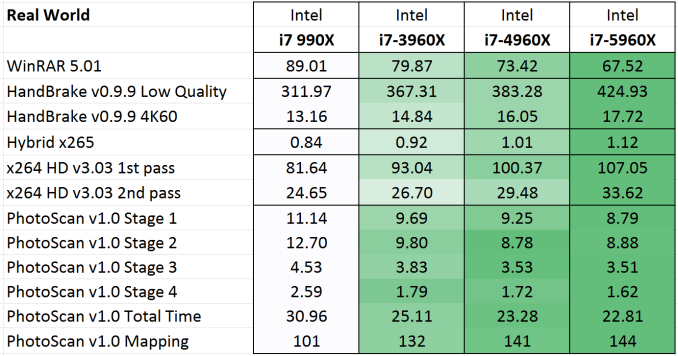


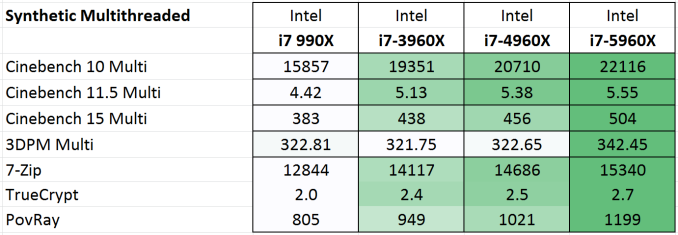

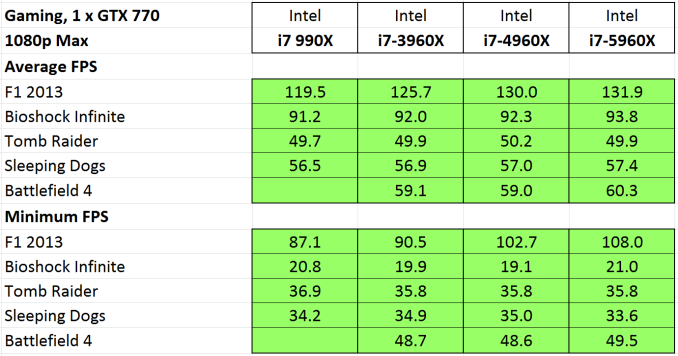
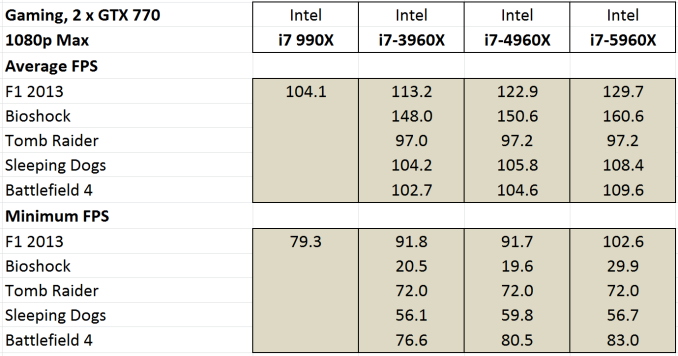
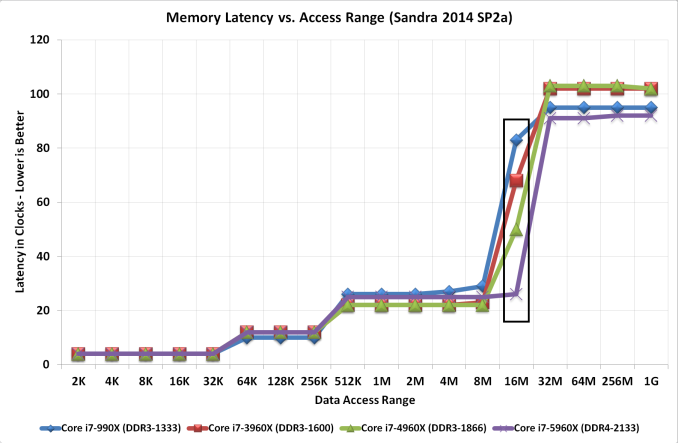








203 Comments
View All Comments
oranos - Sunday, August 31, 2014 - link
Just like with anything in life, there are some people who will pay a premium to have the best of the best. This is exactly that.oranos - Sunday, August 31, 2014 - link
As a matter of fact, for the next generation (nvidia 9xx series and amd xxx) in quad sli/xfire setups, this chip will allow more bandwidth through the PCI-E lanes. So for the top 1% of setups this chip does matter.mlambert890 - Monday, September 1, 2014 - link
no it wont. my p7x79ws with 3960x and tri sli titan has 40 native pcie 3 lanes. sb-e has 40 lanes and pcie 3 support. advanced x79 boards with current bios fully support.this is a non upgrade honestly (x99) vs a high end x79. all you really get is usb3 and sata 6Gb/s native vs third party integrated (BFD), and the mixed bag that is ddr4
Fedor - Monday, September 1, 2014 - link
Very strangely, tomshardware has the 5820 beating out the 5930 and 5960 in gaming benchmarks. The test platforms here and there are very different, but for a start it would be great if you guys could also show us some results with a single GPU for the 5820 and 5930.TiGr1982 - Tuesday, September 2, 2014 - link
IMHO, tomshardware messed up something here - there is no physical reason why 5820 can beat 5930, because they have the same core count and cache structure, but 5930 has higher frequencies and 40 PCIe lanes vs 28 lanes of 5820.Fedor - Wednesday, September 3, 2014 - link
Yup, I'm leaning towards the same conclusion. It's a shame that most reviews do not cover anything but the highest-end chip, but between anandtech, tomshardware, 3dguru and another review I found in Belgian (the graphs were self-explanatory at least ;) only tomshardware has that anomaly, so I'm inclined to agree.Bombreezey - Monday, September 1, 2014 - link
These cpu's would be more beneficial to higher resolution gaming. I love how people are trying to compare this new cpu's to the i5-2500k. There is nothing wrong with the 2500k when gaming at 1080p but when the time comes when people start witching over to 4k gaming when it becomes more affordable your 2500k is gonna struggle big time. Like people have said earlier, there is more to computing than gaming. These cpu's will be vastly faster at video converting/rendering, and other cpu intensive applications when compared to older series of intel cpu's. On another note I see people are complaining about heat because of the high tdp... when there are more cores its gonna need more power......soooooo get a water cooler and problem solve :). At least the tdp isnt 220watts like amd 8 core cpu. So 150watts is pretty fair for a intel 8 core cpu that straight up murders a AMD 8 CORE CPU.untoreh - Friday, September 12, 2014 - link
amd octa core costs 1/4 of the intel octa core, if not 1/5.soldier45 - Monday, September 1, 2014 - link
Was thinking of moving from my 2600k at 4.8 to the 5930k but really not worth the $ for a 20% boost in certain apps and little to no improvement in gaming.ryanbrod - Monday, September 1, 2014 - link
Why is it that every review of the haswell-e chipsets doesn't even make an attempt to saturate more then 16 pcie lanes... The whole point of the haswell-e chips in my opinion is the extra PCIe Lanes for tri and quad sli/crossfire set ups. dual gtx 770s is a joke of a review if you ask me. Put in at least 3 of them or dont do a gaming review at all because its going to be less then 2% difference in performance from regular i7s.